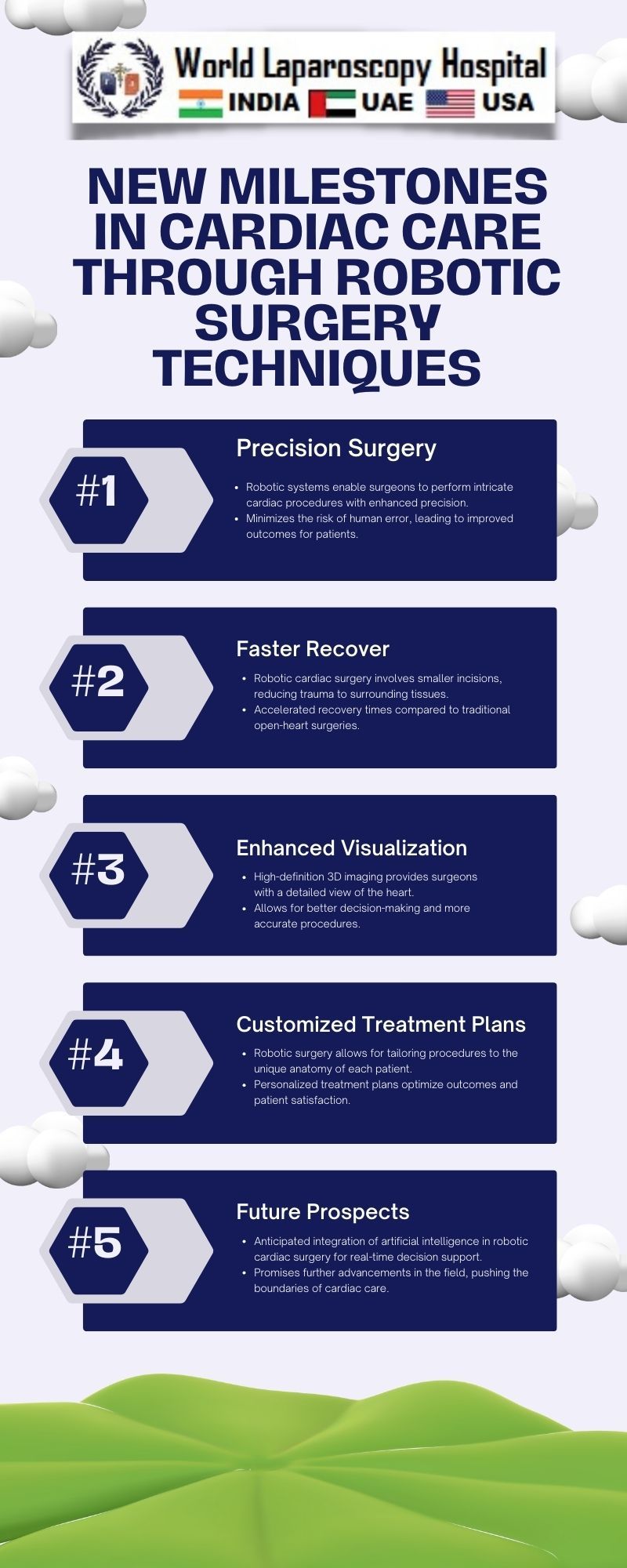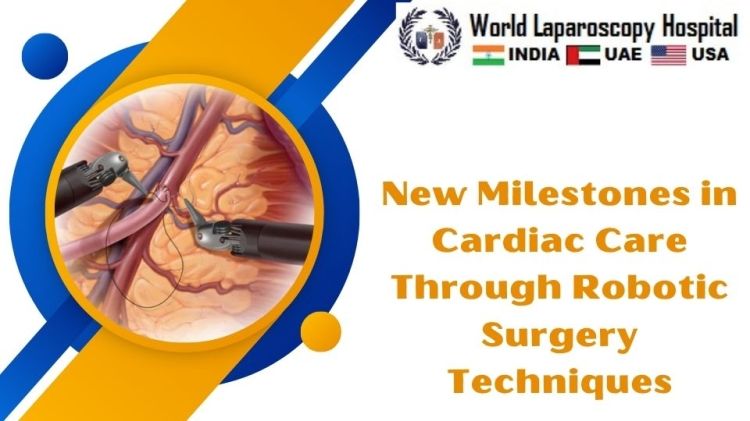Introduction
In recent years, the field of cardiac care has witnessed a paradigm shift with the integration of robotic surgery techniques. The marriage of cutting-edge robotics and cardiac surgery has led to groundbreaking advancements, redefining the landscape of cardiovascular interventions. This article delves into the new milestones achieved through robotic surgery techniques, exploring their impact on precision, patient outcomes, and the future of cardiac care.

Evolution of Cardiac Surgery
Before delving into the specifics of robotic surgery, it's essential to understand the evolution of cardiac surgery. Traditional open-heart surgery, though effective, involves a sternotomy, where the chest is opened, and the heart is exposed. While this approach has been successful in treating various cardiac conditions, it comes with inherent challenges, including prolonged recovery times, increased pain, and higher risks of complications.
The Emergence of Robotic Surgery
Robotic surgery emerged as a revolutionary alternative to traditional methods, aiming to overcome the limitations associated with open-heart procedures. The advent of robotic-assisted surgery in the 1990s marked a significant milestone, introducing enhanced precision and dexterity to the field. The da Vinci Surgical System, a pioneering robotic platform, played a pivotal role in this transformation.
Robotic Surgery in Cardiac Care
Precision and AccuracyRobotic surgery brings unparalleled precision to cardiac procedures. The robotic arms, controlled by a surgeon from a console, offer a range of motion and precision that surpass human capabilities. This precision is particularly crucial in delicate cardiac surgeries where accuracy is paramount.
Minimally Invasive ProceduresOne of the most significant advantages of robotic surgery in cardiac care is its minimally invasive nature. Unlike traditional open-heart surgeries, robotic procedures involve small incisions, reducing trauma to surrounding tissues. This results in less pain, quicker recovery times, and smaller scars for patients.
Improved VisualizationRobotic systems provide surgeons with three-dimensional, high-definition visuals, surpassing what is achievable through traditional methods. This enhanced visualization allows for a more detailed examination of the surgical site, aiding surgeons in making informed decisions during the procedure.
Milestones in Cardiac Robotic Surgery
Coronary Artery Bypass Surgery (CABG)Robotic surgery has transformed the landscape of coronary artery bypass surgery, a common procedure to treat blocked arteries. With the da Vinci Surgical System, surgeons can perform CABG with smaller incisions, reducing the need for a sternotomy. This not only improves cosmetic outcomes but also accelerates patient recovery.
Mitral Valve Repair and ReplacementThe mitral valve, crucial for maintaining proper blood flow in the heart, often requires surgical intervention. Robotic surgery enables precise repairs or replacements of the mitral valve with minimal invasiveness. Patients undergoing robotic mitral valve procedures experience reduced pain, shorter hospital stays, and faster return to normal activities.
Atrial Fibrillation AblationAtrial fibrillation, a common heart rhythm disorder, can be effectively treated through ablation procedures. Robotic-assisted techniques enhance the precision of catheter-based ablation, targeting specific areas of the heart responsible for irregular rhythms. This approach minimizes the risk of complications and improves the overall success rate of the procedure.
Cardiac Tumor ResectionRobotic surgery has also proven successful in the resection of cardiac tumors. With its high precision, surgeons can navigate complex anatomical structures, ensuring thorough removal of tumors while minimizing damage to surrounding healthy tissue. This has opened new possibilities for treating previously challenging cardiac conditions.
Advantages and Challenges
Advantages of Robotic Surgery in Cardiac Care
Minimized Trauma:
Smaller incisions reduce trauma to surrounding tissues, resulting in less pain and faster recovery.
Enhanced Precision:
Robotic systems offer surgeons enhanced precision, vital for intricate cardiac procedures.
Improved Visualization:
High-definition, three-dimensional visuals improve the surgeon's ability to navigate and operate.
Challenges and Considerations
Cost:
The initial investment and maintenance of robotic systems can be significant, raising concerns about cost-effectiveness.
Training:
Surgeons need specialized training to master robotic surgery techniques, contributing to a potential learning curve.
Limited Haptic Feedback:
The absence of direct touch feedback in robotic surgery is a challenge, requiring surgeons to rely on visual and auditory cues.
Patient Outcomes and Quality of Life
The integration of robotic surgery into cardiac care has resulted in notable improvements in patient outcomes and quality of life. Studies have shown that patients undergoing robotic procedures experience less pain, reduced blood loss, and shorter hospital stays compared to those undergoing traditional open-heart surgeries. Moreover, the cosmetic benefits of smaller incisions contribute to improved psychological well-being for patients.
Future Directions and Innovations
Artificial Intelligence in Robotic Cardiac Surgery
The synergy between artificial intelligence (AI) and robotic surgery holds immense potential in advancing cardiac care. AI algorithms can assist surgeons by analyzing data in real-time, providing insights, and even automating certain aspects of the surgical process. This collaboration may further enhance the precision and efficiency of robotic cardiac procedures.
Remote Robotic SurgeryAdvancements in telemedicine and robotics may pave the way for remote robotic surgery. Surgeons could potentially perform cardiac procedures from a remote location, bringing specialized care to underserved areas. While technical and regulatory challenges exist, the prospect of expanding access to advanced cardiac care is promising.
Integration of 3D PrintingThe integration of 3D printing technology with robotic surgery could revolutionize preoperative planning and personalized implants. Surgeons can use 3D-printed models of patients' hearts to simulate procedures, allowing for precise preoperative analysis and customized solutions. This innovative approach may further improve surgical outcomes.
Ethical Considerations and Patient Awareness
As the field of robotic cardiac surgery continues to advance, ethical considerations become paramount. Ensuring patient autonomy, informed consent, and addressing potential biases in technology are crucial aspects of responsible implementation. Additionally, raising awareness among patients about the benefits and limitations of robotic surgery is essential for fostering trust and informed decision-making.
Conclusion
The integration of robotic surgery techniques into cardiac care represents a transformative chapter in the history of cardiovascular interventions. From enhanced precision and minimally invasive procedures to improved patient outcomes, the impact of robotics is undeniable. As technology continues to evolve, the future holds exciting possibilities for further innovation, ultimately shaping a new era in cardiac surgery that prioritizes both efficacy and patient well-being.
